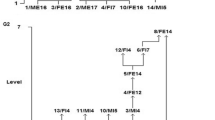Abstract
The affinitive interactions among the pygmy chimps seem to be the most frequent in the male/female combination, next in the female/female, and the least frequent in the male/male. The differences of frequencies among the combinations, however, are little, and it may be said that the pygmy chimps are not so much biased by sex in the affinitive relations. Their aggressive behavior is mild, and their behavior in general shows high tolerance, especially between different sexes and among females. Similar tendency is also seen in grouping (Kuroda, 1979). Therefore, the pygmy chimp’s society may be said to be integrated by the male/female affinity, little differentiated by sex in the grouping and the affinitive relations, and with high inter-individual tolerance and coherence.
Similar content being viewed by others
References
Bruner, J. S., 1976. Nature and uses of immaturity. In:Play,J. S. Bruner,A. Jolly, &K. Sylva (eds.), Penguin Books, Harmondsworth, Middlesex, pp. 28–64.
Coolidge, H. J., 1933.Pan paniscus, pygmy chimpanzee from south of the Congo River.Am. J. Phys. Anthrop., 18: 1–59.
Horn, A., 1975. Adaptations of the pygmy chimpanzee (Pan paniscus) to the forest of the Zaïre Basin.Am. J. Phys. Anthrop., 42: 307.
Kano, T., 1974. The pygmy chimpanzee.Shizen, 7: 28–37. (in Japanese)
————, 1979. Sex and social life of pygmy chimpanzees.Anima, 70: 58–66. (in Japanese)
----, in press a. An ecological and sociological study of the pygmy chimpanzee (Pan paniscus) on the right bank of the Njali River. In:The Pygmy Chimpanzee,T. Kano (ed.), NHK, Tokyo. (in Japanese)
----, in press b. Social interaction among pygmy chimpanzees. In:The Pygmy Chimpanzee.T. Kano (ed.), NHK, Tokyo. (in Japanese)
----, in prep. Social behavior of pygmy chimpanzees of Wamba: A preliminary report.
Köhler, W., 1962.Intelligenzprufungen an Menschenaffen. Second ed. (Japanese trans. byK. Miya)
Kuroda, S., 1977. Pygmy chimpanzees in Wamba.Monkey, 21(6): 6–15. (in Japanese)
————, 1979. Grouping of the pygmy chimpanzees.Primates, 20: 161–183.
----, in press a. Social behavior of pygmy chimpanzees in Wamba. In:The Pygmy Chimpanzee,T. Kano (ed.), NHK, Tokyo. (in Japanese)
----, in press b. Natural life of pygmy chimpanzees in Wamba. In:The Pygmy Chimpanzee,T. Kano (ed.), NHK, Tokyo. (in Japanese)
Lawick-Goodall, J. van, 1968. The behaviour of free-living chimpanzees in the Gombe Stream Reserve.Anim. Behav. Monogr., 1(3): 161–311.
————, 1971.In the Shadow of Man. Houghton Mifflin Co., Boston.
Nishida, T., 1968. The social group of wild chimpanzees in the Mahali Mountains.Primates, 9: 167–224.
————, 1970. Social behavior and relationships among wild chimpanzees of the Mahali Mountains.Primates, 11: 47–87.
————, 1972. Preliminary information of the pygmy chimpanzees (Pan paniscus) of the Congo Basin.Primates, 13: 415–425.
————, 1977a. Chimpanzees in the Mahali Mountains (I): Their natural life and structure of the unit group. In:Chimpanzee-ki (The Chimpanzees),J. Itani (ed.), Kôdansha, Tokyo, pp. 543–638. (in Japanese)
————, 1977b. Social structure of chimpanzees. In:Jinrugaku-kôza (Anthropology),Vol. 2 Reichôrui (Primates),J. Itani (ed.), Yuzankaku, Tokyo, pp. 277–314. (in Japanese)
Pilbeam, D., 1972.The Ascent of Man. The Macmillan Co., New York.
Reynolds, V. &F. Reynolds, 1965. Chimpanzees of the Budongo Forest. In:Primate Behavior: Field Studies of Monkeys and Apes,I. DeVore (ed.), Holt, Rinehart, & Winston, New York, pp. 368–424.
Riss, D. &J. Goodall, 1976. Sleeping behaviour and associations in a group of captive chimpanzees.Folia Primat., 25: 1–11.
Savage, E. S. & R. Bakeman, 1976. Sexual morphology and behavior inPan paniscus. In:Recent Advances in Primatology,D. J. Chivers & J. Herbert (eds.), Academic Press, pp. 613–616.
Sugiyama, Y., 1969. Social behavior of chimpanzees in the Budongo Forest, Uganda.Primates, 10: 197–225.
Author information
Authors and Affiliations
Additional information
This study was financed by the Scientific Research Fund of the Ministry of Education, Science, and Culture of the Japanese Government. This study was carried out as part of academic cooperation between l’Institut de Recherche Scientifique (I.R.S.) du Zaïre and Kyoto University.
About this article
Cite this article
Kuroda, S. Social behavior of the pygmy chimpanzees. Primates 21, 181–197 (1980). https://doi.org/10.1007/BF02374032
Received:
Accepted:
Issue Date:
DOI: https://doi.org/10.1007/BF02374032




